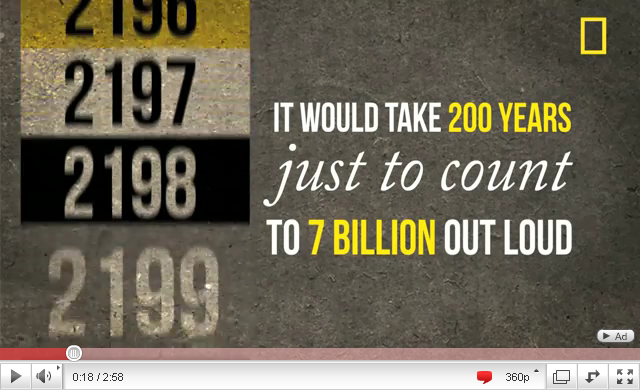The rate at which the human population is increasing is phenomenal. In just 199 years we have gone from a world population of 1 billion to 6 billion. This year, just 12 years after hitting 6 billion, we are going to pass the 7 billion mark.
7 billion is a big number, and this National Geographic video does a good job of making you realize just how big it is. The standout facts for me are that 5 people are born every second, but only 2 people die. That's a population increase of 180 people every minute of the day.
On the flip side to the amount of people there are, we apparently don't take up very much space. Crowd us shoulder to shoulder and 7 billion people only fill an area the size of Los Angeles. In reality we all have our own space, be it a large house or a small shack somewhere in the world.
Still, the world has to cope somehow, and the population is set to increase to 9 billion by 2045. More of us are moving to cities, and overcrowding will become an increasing problem. I don't envy the job of future local governments figuring out how to house us all and clean up after us every day.
Although population issues are politically sensitive, the magazine doesn’t shy away from asking the obvious question:
Right now on Earth, water tables are falling, soil is eroding, glaciers are melting, and fish stocks are vanishing. . . . Decades from now . . . there will be billions more people wanting and deserving to boost themselves out of poverty. If they follow the path blazed by wealthy countries—clearing forests, burning coal and oil, freely scattering fertilizers and pesticides—they too will be stepping hard on the planet’s natural resources. How exactly is this going to work?
Not to keep you in suspense, the article never quite answers its own question. Noting the vastly greater levels of consumption in the developed world, it rightly points out that “how people consume resources matters a lot more” than the total number of people.
But then it offers another conundrum: “The central challenge for the future of people and the planet is how to raise more of us out of poverty—the slum dwellers in Delhi, the subsistence farmers in Rwanda—while reducing the impact each of us has on the planet.”
A recent report by WWF concluded that the Earth’s productive capacity is already overextended, and that by 2030 the world’s population will need the equivalent of two Earths to meet its resource needs sustainably. As the introduction stated,
The implications are clear. Rich nations must find ways to live much more lightly on the Earth, to sharply reduce their footprint, in particular their reliance on fossil fuels. Put plainly, we have to devise ways of getting as much, and more, from much less.
A distinguished group of scientists, writing in the Proceedings of the National Academy of Sciences in October, reported that slowing the Earth’s population growth could achieve 16 to 29 percent of the greenhouse gas emissions reductions needed to keep the planet from seriously overheating. They pointed out that curbing population growth matters both in the developed world, where emissions are highest, and in the developing world, where emissions are rising fast.
On the other hand, population control clearly isn’t sufficient by itself. A study published in September noted that from 1980 to 2005, China accounted for 44.5 percent of global emissions growth, even as its population growth rate declined.

